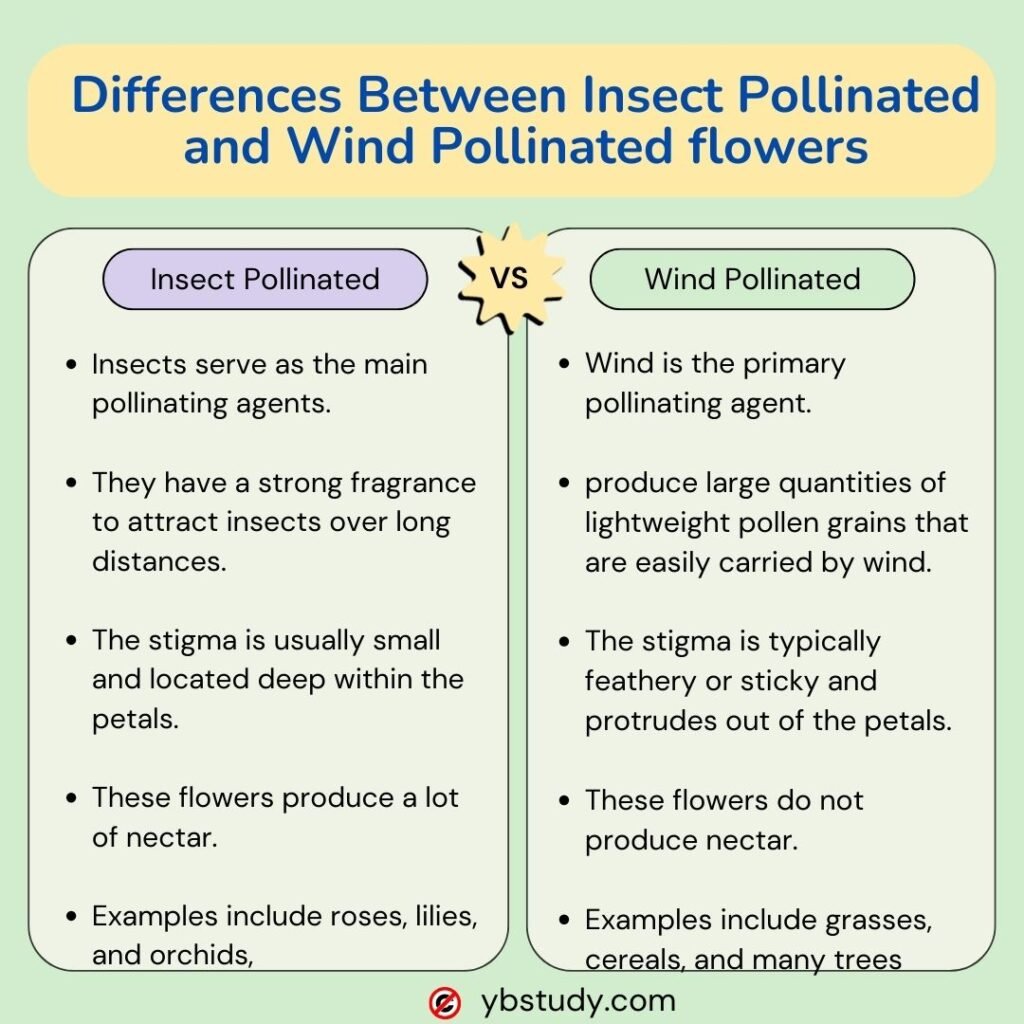10+ key Differences Between Insect Pollinated and Wind Pollinated flowers
Hello Students, In last post we discussed about 10+ Key Difference Between Lysosomes and Ribosomes, Today we are going to discuss about key Differences Between Insect Pollinated and Wind pollinated flowers. So let’s break down the differences between insect and wind pollination in a fun and simple way.
Imagine you are in a garden filled with colorful, sweet-smelling flowers. These flowers are perfect for attracting insects like bees and butterflies. This is called insect pollination. The insects visit the flowers, get covered in pollen, and then carry it to other flowers. This helps the plants make seeds and grow new flowers.
Now, think of another garden where the flowers are small, dull, and not very interesting. These flowers don’t need to attract insects because they rely on the wind to spread their pollen. This is wind pollination. The wind blows the pollen from one flower to another, helping the plants reproduce.
In short, insect-pollinated flowers are bright and fragrant to attract insects, while wind-pollinated flowers are plain and rely on the wind. Both methods are essential for plants to produce seeds and continue their species.
10+ key Differences Between Insect Pollinated and Wind Pollinated Flowers
| Insect-Pollinated Flowers | Wind-Pollinated Flowers |
|---|---|
| Insects serve as the main pollinating agents. | Wind is the primary pollinating agent. |
| Insect-pollinated flowers have brightly colored petals and produce nectar to attract insects such as bees, butterflies, and beetles. | The wind-pollinated flowers have light coloured petals, without a pleasant strong smell. |
| They have a strong fragrance to attract insects over long distances. | Wind-pollinated flowers produce large quantities of lightweight pollen grains that are easily carried by the wind. |
| The stigma is usually small and located deep within the petals. | The stigma is typically feathery or sticky and protrudes out of the petals. |
| The stamens are often small and concealed within the petals. | The stamens are long and extend out of the petals. |
| Pollen grains are sticky or spiky to adhere to insect bodies. | Pollen grains are smooth and small to be carried by the wind effectively. |
| These flowers produce a lot of nectar. | These flowers do not produce nectar. |
| In insect-pollinated flowers, the pollen grains are larger in size, sticky and spiny which helps the insects to carry the pollen grains. | In wind-pollinated flowers, the pollen grains are smaller and lighter in weight, which can be carried by the wind easily. |
| Structures such as stamens and pistils are often positioned to ensure contact with visiting insects. | Flowers have exposed stamens and pistils to facilitate direct exposure to wind currents for pollen transfer. |
| Examples include roses, lilies, and orchids, which require precise pollination to reproduce effectively. | Examples include grasses, cereals, and many trees like oaks and birches that produce large amounts of pollen. |
5+ key Differences Between Insect Pollinated and Wind Pollinated flowers

Similar Articles:
- What is the difference between viruses, bacteria, and microorganisms?
- Difference Between Air and Water Pollution
- 5 key differences between Pathogen and Parasite PDF
- 5 key Difference Between Antigen and Pathogen
- 5 Key Difference Between Brain and Spinal
- 5 Key Difference Between Plants and Trees
- 5 Key Difference between Adolescence and Puberty
- 5 Key Differences Between Bacteria and Fungi
- Difference Between Animal Cell and Plant Cell
- Difference Between Active and Passive Transport
